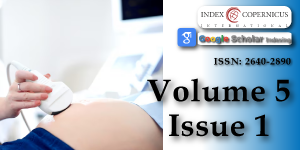Severe preeclampsia at the University Hospital Center of Mother and Child (UHCMC) in N’djamena: Epidemiology and prognosis
Main Article Content
Abstract
Introduction: Preeclampsia constitutes a public health problem in our region. According to the WHO, it is the third cause of maternal mortality after severe hemorrhages, infections and is responsible for morbidity and high fetal mortality. The aim of this study was to improve on the management of severe preeclampsia at the University Hospital Center of Mother and Child (UHCMC) in N’Djamena.
Patients and methods: It was a prospective and descriptive survey of 3 years duration, from January 01st, 2017 to December 31st, 2019. Included in our study were, all patients admitted for severe preeclampsia and agreed to participate in the study. Epidemiological, clinical, therapeutic and prognostic studies were conducted. The data collected was analyzed using SPSS 18.0 software.
Results: During the study period, 13599 pregnant and parturients were admitted to the Gynecology-Obstetrics department of the UHCMC, among whom 406 cases of severe preeclampsia, with a frequency of 2.9%. The patients were young (23.2 years), married (96.3%), primipara (61.3%), referred (64.3%) without antenatal care in 47.9% of cases. Functional signs were dominated by headaches with 34.0% of cases. The proteinuria was ≥ 3 crosses in 83.7% of cases. Patients had received magnesium sulfate in 98.3%, the delivery mode was cesarean in 64.0% of cases. Principal morbidity was eclampsia (40.8%) and fetal was prematurity (36.4%). Maternal lethality was 11.1% and fetal mortality was 19.9% cases.
Conclusion: Severe preeclampsia is frequent in the UHCMC in N’Djamena. It is responsible for high maternal and fetal mortality. The practice of quality antenatal care, could prevent the occurrence of complications and improve the maternal-fetal prognosis.
Article Details
Copyright (c) 2022 Foumsou L, et al.

This work is licensed under a Creative Commons Attribution 4.0 International License.
American College of Obstetricians and Gynecologists, Committee in practice Obstetrics. Gestational Hypertension and Preeclampsia. Pract Bull. 2019; 133: e1-e25. PubMed: https://pubmed.ncbi.nlm.nih.gov/30575675/
World Health Organization. Recommendations for the Prevention and Treatment of Pre-eclampsia and Eclampsia. WHO. 2014; 39. www.who.int/reproductivehealth/ publications/maternal_perinatal_health/9789241548335/en/index.html
French College of Gynecologists and Obstetricians (NCFGO) and French Anesthesia and Reanimation Society. Formalized Expert Recommendations. Management of the patient with severe preeclampsia. NCFGO. 2020; 38.
Cissé CT, Thiam M, Diagne PM, Moreau JC. Pre-eclampsia in the African environment: epidemiology and prognosis in University Hospital of Dakar. Letter of Gynecologist. 2005; 301: 8-13.
Obosou AAA, Salifou K, Hounkapatin B, Hounkponou F, Quenum CT, et al. Epidemiological and prognostic aspects of severe preeclampsia at the maternity in Borgou Departmental Hospital of Parakou (Benin). Parakou University. Ann Health Sci Series. 2012; 2: 1-3.
Madoué GB, Lhagadang F, Silé SN, Dorenavant D. Management of Severe Preeclampsia Before Term in N’Djamena Mother and Child University Hospital. J Gynaecol Womens Healthcare. 2021; 3: 5.
Tchente NC, Belley PE, Halle EG, Fofack TLJ, Nana NT, et al. Complications and management of preeclampsia and eclampsia in Douala general hospital. Revi Med Pharm. 2015; 5: 483-490.
Tchaou BA, Tshabu-aguemon TC, Hounkponou NFM, Adisso S, Aguemon AR, et al. Severity and prognosis of patients treated for severe preeclampsia Parakou Departmental University Hospital (Benin). Black Afr Med. 2013; 489-495.
Tshabu-aguemon TC, Ogourindé MO, Megnissé SH, Lokossou S, Bejamin H, et al. Prognostic factors of severe preeclampsia in University Maternity Hospital of Porto-Novo in Benin. J Soc Biol Benin. 2017; 27: 59-64.
Rajni P, Chitra S. Maternal and perinatal outcome of severe preeclampsia and eclampsia. JMSCR. 2020; 8: 242-245.
Mervielle P, Dumont A, Bonnardot J, PerierJF, Rondeau E, et al. Severe pre-eclampsia: management, conservative treatment justified? J Gynaecol Obstet Biol Reprod. 2014; 26: 238-249. PubMed: https://pubmed.ncbi.nlm.nih.gov/9265044/
Keita M, Diallo B, Samaké B, Foumba S, Dicko H, et al. Epidemiology and maternal prognosis of eclampsia in reanimation service in the Bamako G-Point University Hospital University. Med Mali. 2016; 31: 1-9. PubMed: https://pubmed.ncbi.nlm.nih.gov/30079675/
Duley L, Henderson-Smart DJ, Walker GJ, Chou D. Magnesium sulfate versus diazepam for eclampsia. Cochrane Database Syst Rev. 2010; 2010: CD000127. PubMed: https://pubmed.ncbi.nlm.nih.gov/21154341/
Girard B, Beucher G, Muris C, Simonet T, Dreyfus M. Magnesium sulphate and severe pre-eclampsia: safety in common practice in targeted indications. J Gynecol Obstet Biol Repord. 2005; 34: 17-22. PubMed: https://pubmed.ncbi.nlm.nih.gov/15767913/
Ahmed TB, Youness B, Sakher M, Naima S. Epidemiology of preeclampsia in Casablanca. PAMJ. 2020; 12: 112-119.
Saxena N, Bava AK, Nandanwar Y. Maternal and perinatal outcome in severe preeclampsia and eclampsia. Int J Reprod Contracept Obstet Gynecol. 2016; 5: 2171-2176.
Foumsou L, Saleh A, Kaimba O. The determinants of maternal mortality in N’Djamena National Reference General Hospital in Chad. Chad Scientific Rev. 2014; 1: 35-41.
Rakotomalala Z, Randriambololona DMA, Andriampanarivo HM, Rakotozanany B, Randriamaromanana ZN, et al. Poor prognosis factors of pre-eclampsia in Madagascar. Trop Health Med. 2016; 26: 78-82.

